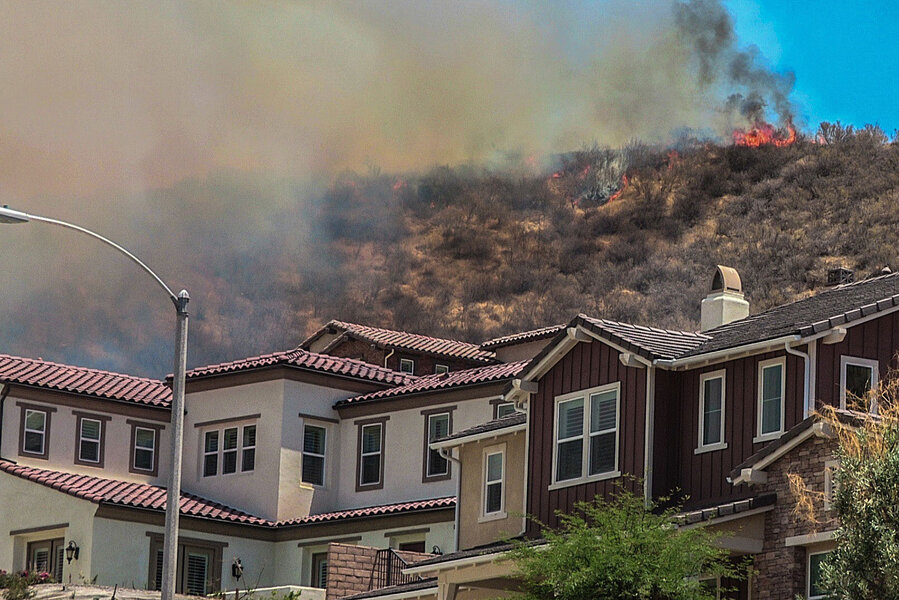Can a California homeowner be sued for a wildfire?
A 2013 wildfire burned 43 square miles near Palm Springs, Calif., threatening a town and costing an estimated $15 million to put out – and the federal government wants Tarek Al-Shawaf to pay for it.
Officials say that Mr. Shawaf's warped electrical box started the fire in the San Jacinto Mountains.
Assigning blame for a forest fire is a drawn-out process of investigation and litigation that can leave individual homeowners with massive liability in a time when Western wildfires are becoming larger and more costly to fight every summer.
"Fire prevention not only requires that you do the fuel reduction on the outside of the home, but also that you have the home 'firewise' so that you don’t start the neighborhood on fire," says Gary Hatch, a retired fire chief in Arizona who spent 25 years fighting wildland fires.
After Sharef refused the US Forest Service request to pay for firefighting costs and damages, the government sued, the Los Angeles Times reported. The $25 million lawsuit will center on whether Sharef knew there was a problem.
"Common sense takes it back to liability," Mr. Hatch tells The Christian Science Monitor. "If he knew it was a problem, then he is liable."
Because the electrical box's plastic lid was too warped to close properly, "an electrical discharge inside the box shot sparks and shot material out of the box and onto dry ground vegetation below," according to the lawsuit. Lawyers for Shawaf, a Saudi businessman who founded Saudconsult, told the Las Angeles Times that the fire did not start as the government claims.
Investigations after fires are put out can now pinpoint a fire's initial spark to within 3 inches, Hatch says. When careless campers leave campfires unattended or homeowners neglect electrical maintenance, a jury must decide whether they had good reason to know it was dangerous.
"Arson fires are set deliberately, but people cause fires in many ways: unattended campfires, fireworks, sparks from equipment or vehicles without working spark arrestors, or burning leaves and debris," according to the US Forest Service Fire and Aviation Management. "It’s everyone’s job to prevent human-caused wildfires."
Not every federal attempt to encourage "firewise" construction is so punitive. Democratic and Republican senators from Colorado, Idaho, and Montana introduced a bill on Wednesday that would fund projects for preventative fire-fighting.
The bill has little chance of passing during a contentious election year, but fire prevention organizations support the legislation because the decades-old budget model requires the Forest Service to "borrow" from funds for prevention every time firefighting costs exceed estimates, the Monitor has reported previously. Wildfires are growing larger each summer, so such shortfalls occur frequently.
The proposed bill would also change the government's emergency action plan from one of assigning cause and blame for each fire to one where wildfires are treated more like floods or tornadoes.
"For every dollar we spend on mitigation efforts like reducing fuel loads, there is an average savings of four dollars in recovery spending," Sen. Michael Bennet (D) of Colorado, a sponsor for the bill, said in a press release.
For now, homeowners have legal responsibility to maintain their homes with a focus on fire prevention or risk liability. If state or federal agencies can prove a fire began for reasons other than an "act of God," they can shift a heavy financial burden onto individual homeowners.
Nearly 45 million homes lie in or near a fire-prone forest or wilderness area, meaning homeowners in 72,000 communities are literally on the front lines of wildfire risk, wrote Michele Steinberg for the National Fire Protection Association. The NFPA encourages these homeowners to create 10 feet of "defensible space" around their homes by pruning trees or moving dead leaves, bushes, and wood piles.
Hatch, the retired fire chief, acknowledges that holding homeowners liable sounds harsh, but he recounted one fire caused by a single cigarette butt. The man who tossed it into his yard would have been liable for all damages, but he was so stricken with guilt he was found dead of a self-inflicted wound, even before the fire that burnt down 68 homes was out.









